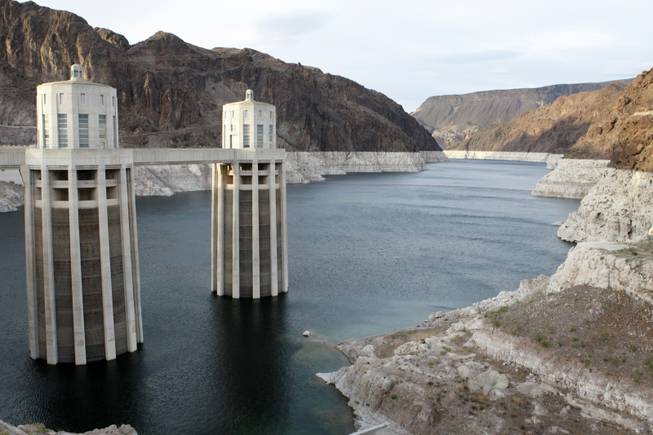
A view of low water levels at Hoover Dam on April 9, 2009. As demand increases for water in cities like Las Vegas, Phoenix and Los Angeles, climate change is projected to reduce available water in the Colorado River to produce periodic shortages, according to a new study.
Wednesday, Sept. 12, 2012 | 2 a.m.
Sun coverage
- Environmental impact statement issued for proposed water pipeline (08-03-2012)
- Water pipeline project hearing wraps up (11-19-2011)
- Nevada leaders largely silent on pipeline controversy (10-14-2011)
- In rural Nevada, everyone worries about the pipeline (08-18-2011)
- Troubled waters: Las Vegas’ perpetual quest to quench itself (08-01-2011)
- Rural Nevada vs. Las Vegas: Battle over water advances (07-06-2011)
- Quenching Las Vegas' Thirst
The Colorado River Commission of Nevada on Tuesday added its weight behind the Southern Nevada Water Authority’s last-resort option to siphon groundwater from counties north of the Las Vegas Valley.
By unanimous voice vote, commissioners approved a three-page letter to the federal Bureau of Land Management supporting the need for a pipeline to bring water from Lincoln and White Pine counties. In March, a state engineer approved a proposal by the Southern Nevada Water Authority to pump 84,000 acre-feet of groundwater from the two counties. Several groups have mounted legal challenges to the proposal.
The letter details Nevada’s need to develop water resources in light of the 1922 pact that grants California 15 times and Arizona nine times more water than Nevada from Lake Mead and the Hoover Dam. Mexico is allowed five times more than Nevada.
The Colorado River Commission of Nevada is the state agency responsible for acquiring and managing Nevada's share of water and hydropower resources from the Colorado River.
Rather than seek a larger water allocation from Lake Mead by legally challenging the 90-year-old compact and all the federal actions that followed, the River Commission letter said it supported the Southern Nevada Water Authority’s plan to create more water resources, including the pipeline to the north.
The Water Authority has outlined plans to build 300 miles of pipeline to carry groundwater from Lincoln and White Pine counties, at a cost estimated to be in the billions. The amount pumped would be enough to supply just over 150,000 homes with water annually.
The letter notes the drought is partly to blame for the decreasing levels of Lake Mead, which is fed by the Colorado River and holds 90 percent of Southern Nevada’s water supply. But that’s not the only reason the lake level is falling.
In the 100 years from 1906 to 2006, the letter says, the average yearly inflow of water into the Colorado River has averaged 13 million to 15 million acre-feet. But annual allocations from the river, which go to seven states — Arizona, Colorado, Nevada, California, Utah, New Mexico and Wyoming — and Mexico total 16.5 million acre-feet. The amount going in, especially during a drought, is less than the amount going out.
“The realities of living in the Southwestern United States,” the letter states, “where 30 million people depend on an over-allocated water resource, is that each Basin State must work tirelessly to diversify its water portfolio within its resources.”
The groundwater-pipeline project, it says, “is necessary for Southern Nevada to continue to drive the economy of the entire state of Nevada.”
Despite the letter, legal challenges remain for the Water Authority to overcome before it can comfortably declare the pipeline as a viable option. Several groups have filed appeals of a March ruling by a state engineer that granted the Water Authority permission to pump the water.

Join the Discussion:
Check this out for a full explanation of our conversion to the LiveFyre commenting system and instructions on how to sign up for an account.
Full comments policy